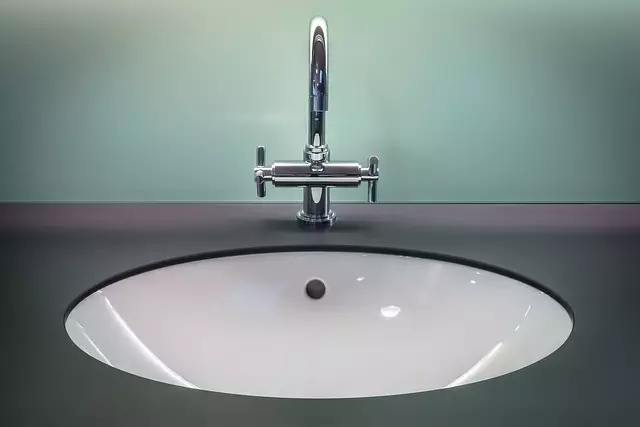Faucet repairs can range from simple fixes like replacing cartridges or O-rings to complex issues requiring professional plumbers. Regular maintenance, including visual inspections and cleaning, prevents leaks, corrosion, and mineral buildup. Having the right tools, materials, and knowledge enables homeowners to handle basic faucet repair, saving time and money. For complex problems, a systematic approach, correct replacement parts, and expert guidance from plumbers are essential for efficient repairs.
In every home, a reliable faucet is a basic need. However, even the most well-maintained fixtures can develop issues over time. This comprehensive guide delves into the world of faucet repairs, equipping you with the knowledge and tools to tackle common problems. From identifying leaks to replacing cartridges, our step-by-step instructions ensure you’re prepared for any emergency. Learn the secrets to effective preventive maintenance and when to call in the pros. Master these skills, and you’ll be well on your way to fixing leaky faucets and ensuring a steady flow of water in your home.
Understanding Common Faucet Issues

Faucets are an integral part of any home, and while they may seem simple in design, common issues can arise that require prompt attention during emergency repairs. Recognizing these problems is the first step towards efficient faucet repair. One of the most frequent concerns is a leaking faucet, often due to worn-out O-rings or cartridge damage. Other typical issues include low water pressure, caused by mineral buildup or aerator obstruction, and faulty temperature control valves.
Proper maintenance can prevent many of these issues, but understanding the basic mechanics behind your faucet will help you identify problems quickly. Regular cleaning and periodic checks for leaks or water pressure drops are essential practices for every homeowner. When an emergency repair is needed, having a basic toolkit and knowledge of common faucet parts can streamline the process, ensuring your faucets function optimally once again.
Tools and Materials for the Job

When tackling a faucet repair, having the right tools and materials is essential for a successful outcome. For most standard faucet issues, you’ll need a few basic hand tools such as adjustable wrenches or pliers to loosen any stubborn parts, along with a new washer or O-ring, which are commonly the culprits behind leaks. A set of screwdrivers in various sizes is also beneficial, as different faucets might require specific types. For more complex repairs involving disassembly, a faucet repair kit can be useful, typically containing all necessary parts and tools for common issues.
Remember to gather these materials before starting your repair to avoid any delays or complications. Having them readily available ensures an efficient process, minimizing water damage and potential hassle. With the right tools at hand, you’ll be well-prepared to tackle various faucet repair jobs.
Step-by-Step Guide to Basic Repairs

When a faucet starts dripping or fails to maintain pressure, it’s often time for a repair. Before calling a professional, try these straightforward steps for basic faucet repairs. Begin by shutting off the water supply to the faucet using the shut-off valves located under the sink. These valves control the flow of water to the faucet and can be tightened or turned counterclockwise to stop the water. Next, gather your tools: a wrench, pliers, and replacement parts if needed. Remove the faucet handle by unscrewing it with a wrench or pliers; this will give you access to the inner mechanisms. Depending on the type of faucet, disassemble the components carefully, paying close attention to any O-rings or washers that may require replacement due to wear and tear.
Once you’ve identified the problematic parts, replace them with new ones if necessary. Ensure all parts are properly aligned and secured before reassembling the faucet. Test the repair by turning on the water supply and checking for leaks at each joint. If the faucet still drips or has low pressure after these steps, consult a professional plumber. However, for simple issues like loose connections or damaged washers, these DIY techniques can save time and money.
Fixing Leaks: Identifying the Source

Leaky faucets can be a common household issue, but identifying and fixing the source is crucial for efficient faucet repair. Start by locating the leak—is it at the base of the faucet handle or the spout? Sometimes, leaks are caused by worn-out O-rings or washers inside the faucet. These parts can be easily replaced, halting the flow of water. If the leak persists, it might be due to a damaged cartridge or valve seat, requiring more intricate faucet repair procedures.
Visual inspection and basic troubleshooting can help homeowners pinpoint the problem. By understanding these issues, you can efficiently navigate the process, saving time and money on potential faucet repair costs.
Replacing Faucet Cartridges or Valves

When it comes to faucet repair, replacing cartridges or valves is often a straightforward process that can save you time and money. This common type of emergency faucet repair is ideal for leaks or low water pressure issues. Cartridges are responsible for controlling the flow of water and mixing hot and cold temperatures, while valves regulate the water’s movement. Identifying which part needs replacement is key; check for any damage or debris in the cartridge or valve area.
Most faucets use replaceable cartridges that can be easily unscrewed and swapped out with new ones. Valves, although slightly more intricate to access, are also designed for easy replacement. Have a spare cartridge or valve on hand will ensure your faucet repair is swift and efficient, minimizing any disruption to your daily routine.
When to Call a Plumber

If you’re facing a leaky faucet, it might be tempting to attempt a DIY repair to save time and money. However, there are certain situations where calling a professional plumber is essential. A plumbing expert is best reached when the issue goes beyond a simple replacement of a washer or O-ring, which can usually be done by homeowners. Complex issues like severe damage to the faucet’s internal components, corrosion, or faulty pipes warrant professional attention.
Additionally, if you’re dealing with a broken or damaged faucet handle, an old or outdated fixture, or a constant flow of water that won’t stop, these are clear signs that it’s time to call a plumber. They have the specialized tools and knowledge to diagnose and fix a wide range of faucet repair issues efficiently, ensuring your home remains in good working order with reliable plumbing systems.
Tips for Preventive Maintenance

Regular maintenance is key to preventing sudden and inconvenient faucet repairs. Start by checking your faucets periodically for any signs of leaks, corrosion, or loose parts. A simple visual inspection can help catch issues early on, saving you from more complex (and costly) problems down the line.
Consider scheduling occasional cleaning sessions, especially for mineral-buildup areas around the faucet head and aerator. Use mild detergent and a soft brush to gently scrub away any residue. Additionally, lubricating the faucet’s moving parts with a silicone spray can prevent stiffness and prolong its lifespan. These simple preventive measures can go a long way in ensuring your faucets remain functional and efficient for years to come, avoiding costly emergency repairs.
Troubleshooting Hard-to-Fix Problems

When it comes to faucet repairs, some issues can be particularly tricky to fix. Hard-to-pinpoint problems often require a systematic approach to troubleshooting. Start by inspecting the faucet for any visible damage or leaks. Check all connections, including supply lines and fittings, as loose or damaged parts are common culprits. If the issue lies within the faucet’s mechanism, identifying the specific problem part—be it the cartridge, washer, or valve seat—is key.
Consider using a repair kit tailored to your faucet model for easier troubleshooting. These kits often come with detailed instructions and replacement parts, making complex repairs more manageable. Online tutorials and DIY guides can also provide step-by-step solutions, ensuring you’re equipped with the knowledge to tackle these challenging faucet repair problems effectively.
Choosing the Right Faucet Repair Parts

When undertaking emergency faucet repairs, selecting the right parts is half the battle won. It’s crucial to identify your faucet model and brand before shopping for replacement components. This ensures compatibility, saving time and frustration. Many modern faucets come with universal repair kits, suitable for various models, making DIY repairs more accessible. However, for older or specialized fixtures, specific parts may be required.
For a successful faucet repair, consider the type of damage. Common issues include leaks, clogged aerators, or damaged valves. Corresponding repair parts are readily available at hardware stores or online retailers, offering a wide array of options tailored to different brands and models. Always check product descriptions and customer reviews for guidance before making a purchase, ensuring you acquire parts that align with your faucet’s unique needs.
